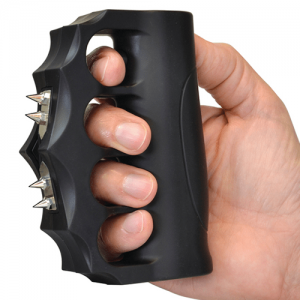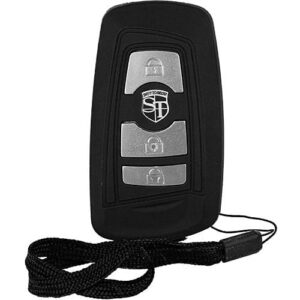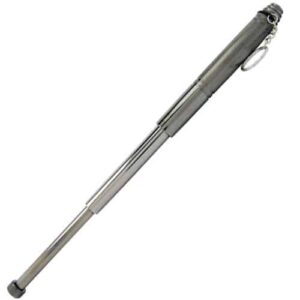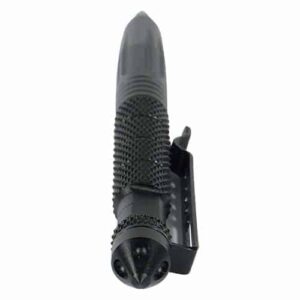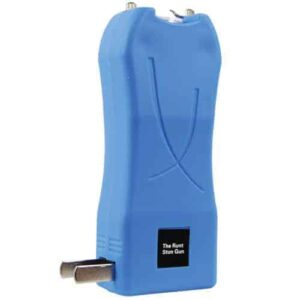So, you think you know all there is to know about Tasers? Think again! Get ready to be amazed by these mind-blowing Taser facts that will leave you stunned (in a good way). From their electrifying history to the mesmerizing science behind them, this article will take you on a journey of discovery. Find out how Tasers became a game-changer for law enforcement, uncover the surprising truth about their safety, and learn about some jaw-dropping Taser feats that will leave you in awe. Get ready to zap your way through the top 10 Taser facts like never before!
Table of Contents
ToggleWhat is a Taser?
Definition of a Taser
A Taser is a non-lethal self-defense weapon that is designed to incapacitate an assailant by delivering an electric shock. It is commonly used by law enforcement agencies and individuals for personal protection. The word “Taser” is actually an acronym for “Thomas A. Swift’s Electric Rifle,” named after the fictitious inventor in the children’s book series by Victor Appleton.
How a Taser works
Tasers work by delivering electrical energy to disrupt the communication between the brain and the muscles, temporarily immobilizing a person. The device works by shooting two electrified probes, typically made of barbed metal wires, towards the target. These probes attach to the person’s clothing or skin and deliver an electric current that interferes with the nervous system, causing temporary muscle paralysis.
Different types of Tasers
There are different types of Tasers available in the market, each designed for specific purposes. The most common type is the handheld Taser, which is typically cylindrical in shape and features a trigger mechanism to deploy the probes. Additionally, there are also compact and concealed Tasers that are specifically designed for discreet carrying options. Law enforcement agencies may use more advanced models that offer additional features and capabilities.
Effectiveness of Tasers
Taser’s impact on the human body
When a Taser is deployed, it can cause strong muscle contractions, loss of balance, and temporary incapacitation. The electric shock delivered by the device overrides the body’s natural electrical signals, causing the muscles to contract uncontrollably. This can effectively disable an attacker, giving the intended victim an opportunity to escape or seek help.
Comparison to other self-defense weapons
Tasers are considered highly effective when compared to other self-defense weapons such as pepper spray or batons. Unlike pepper spray, which relies on chemical irritants to incapacitate an attacker, Tasers work regardless of pain tolerance or the attacker’s mental state. Additionally, while batons require physical contact with the assailant, Tasers can incapacitate an attacker from a safe distance, reducing the risk of physical harm to the user.
Success rate of Taser deployments
Studies have shown that Tasers have a high success rate in effectively incapacitating attackers. According to a report by the Police Executive Research Forum, the overall success rate in achieving incapacitation with a Taser was nearly 96%. This indicates that in the majority of instances where a Taser was deployed, it successfully immobilized the target and provided a safe resolution to potentially violent confrontations.
Taser Laws and Regulations
Legalities of owning a Taser
The legalities surrounding the ownership of a Taser vary depending on the jurisdiction. In some places, owning a Taser is legal for both civilians and law enforcement officers. However, in certain areas, Tasers may be classified as restricted or prohibited weapons, requiring a specific permit or license to possess. It is important to familiarize oneself with local laws and regulations before purchasing a Taser.
Restrictions on Taser usage
While Tasers are an effective means of self-defense, their use is subject to specific restrictions in many jurisdictions. For instance, the use of a Taser is generally prohibited for offensive purposes or in situations where there is no immediate threat. It is essential to understand when and where the use of a Taser is legally justified to ensure compliance with local regulations.
Concealed carry laws for Tasers
Concealed carry laws apply to the manner in which a Taser is carried and concealed on an individual’s person. In some jurisdictions, a concealed carry permit may be required to carry a Taser, just as it would be for carrying a concealed firearm. These laws aim to ensure responsible and safe carrying of Tasers in public spaces.
Taser Usage by Law Enforcement
Deployment guidelines for law enforcement
Law enforcement agencies have established specific guidelines for the deployment of Tasers to ensure their responsible and effective use. These guidelines typically dictate when officers may use a Taser as an alternative to lethal force, including specific situations where the use of a Taser is warranted. The guidelines also emphasize the importance of proper training and de-escalation techniques to minimize the risk of excessive force.
Controversies surrounding Taser use by police
Despite the widespread use of Tasers by law enforcement, there have been controversies surrounding their use. Critics argue that improper usage or excessive deployment of Tasers can result in serious injury or even death. This has led to discussions and debates regarding the accountability and training of police officers when it comes to using Tasers as a means of force.
Training requirements for police officers
To ensure safe and effective use, law enforcement officers typically undergo comprehensive training on the appropriate use of Tasers. This training includes understanding the physiological effects of Tasers on the human body, practicing proper deployment techniques, and learning de-escalation strategies to minimize the need for Taser usage. Regular training sessions and refresher courses are often implemented to reinforce proper utilization and safety measures.
Taser Safety Precautions
Proper usage techniques
To ensure the safety of both the user and the target, it is important to follow proper usage techniques when deploying a Taser. This includes aiming for the lower center body mass to minimize the risk of accidental injury to vital organs. Users should also be mindful of any potential obstructions that may affect the effectiveness of the device, such as thick clothing or barriers.
Potential risks and side effects
While Tasers are generally considered safe, there are potential risks and side effects associated with their use. Some individuals may experience minor injuries or burns at the site of the probes’ entry or exit points. In rare cases, Tasers may also cause more severe injuries, especially if the target has a pre-existing medical condition. It is important to be aware of these risks and use Tasers responsibly.
Safety recommendations for Taser owners
For individuals who own a Taser for personal protection, it is crucial to prioritize safety. This includes keeping the device securely stored and out of reach of children or unauthorized individuals. Regular maintenance checks should also be conducted to ensure the device is functioning properly, and any malfunctions should be addressed immediately. Proper training on Taser usage and safety precautions is highly recommended for all Taser owners.
Taser Voltage and Amperage
How voltage affects the effectiveness
Voltage plays a key role in determining the effectiveness of a Taser. Higher voltages result in a more potent electric shock, which can overcome the resistance of an attacker’s clothing or skin. However, it is important to note that higher voltage does not necessarily equate to a more effective or safer device. Factors such as barb penetration and positioning also impact the overall effectiveness of a Taser.
Understanding the amperage output
Amperage refers to the amount of electrical current flowing from the Taser. Tasers typically have a low amperage output, ensuring that the device delivers a high-voltage shock without causing significant damage or harm to the person on the receiving end. This design feature makes Tasers a non-lethal option while still effectively incapacitating an attacker.
Misconceptions about Taser power
There are several misconceptions surrounding the power of Tasers, with some mistakenly believing that higher voltage or amperage equates to a more powerful device. In reality, the effectiveness of a Taser depends on a combination of factors, including voltage, barb penetration, and proper deployment. It is important to consider these factors holistically rather than focusing solely on voltage or amperage when evaluating a Taser’s capability.
Taser vs Stun Gun
Differences between Tasers and stun guns
While Tasers and stun guns are both self-defense weapons, they differ in their mechanisms of action. A Taser uses electrical probes that are shot from a distance to incapacitate an attacker, while a stun gun requires direct physical contact with the assailant to deliver an electric shock. Additionally, Tasers typically have a longer range and can immobilize an attacker from several feet away, providing a safer distance for the user.
Advantages and disadvantages of each
Tasers and stun guns each have their own advantages and disadvantages. The advantages of a Taser include the ability to incapacitate an attacker from a safe distance, a higher success rate in achieving immobilization, and reduced risk of physical harm to the user. On the other hand, stun guns are generally more compact, easier to carry, and provide a more immediate response when used in close-range encounters. It is important to consider individual preferences and circumstances when choosing between the two.
Choosing the right self-defense device
Selecting the appropriate self-defense device depends on various factors, including personal comfort, legal restrictions, and the intended use. If long-range immobilization is a priority and legal ownership is permitted, a Taser may be the preferred choice. Conversely, if close-quarters defense and portability are of utmost importance, a stun gun may be more suitable. It is essential to evaluate one’s specific needs and consult local laws before making a decision.
Taser Use in Self-Defense
Legal justification for self-defense use
The use of a Taser for self-defense is typically justified when there is a reasonable belief of an immediate threat or danger to oneself or others. Self-defense laws vary by jurisdiction but generally allow individuals to use reasonable force to protect themselves from harm. However, it is important to understand the specific legal requirements and limitations surrounding self-defense in one’s place of residence.
Key considerations before deploying a Taser
Before deploying a Taser as a means of self-defense, several key considerations should be taken into account. It is crucial to assess the situation and determine if non-lethal force is appropriate and necessary. Factors such as distance, potential bystanders, and the attacker’s level of aggression should be carefully evaluated. Additionally, awareness of local laws and regulations is essential to ensure compliance and avoid legal repercussions.
Effectiveness in incapacitating attackers
Tasers have proven to be highly effective in incapacitating attackers when used correctly. The electric shock delivered by a Taser temporarily overrides the nervous system, rendering the attacker unable to continue their assault. However, it is important to remember that a Taser may not always be a guaranteed solution, as individual variability and situational factors can impact effectiveness. Adequate training and preparation are vital to maximize the chances of successful self-defense.
Taser Battery Life and Maintenance
How long does a Taser battery last?
The battery life of a Taser can vary depending on the model and frequency of usage. Generally, most Taser models can last for several years if not used regularly. However, it is recommended to periodically check the battery and replace it if necessary to ensure the device remains reliable and functional in times of need.
Tips for maintaining optimal battery performance
To maintain optimal battery performance, it is important to follow the manufacturer’s guidelines and recommendations. Storing the Taser in a cool and dry environment can help prolong the battery life. Regularly inspecting the device for any signs of damage or malfunction is also essential. Finally, engaging in regular training sessions and practice deployments ensures familiarity with the device and its functions.
Replacing and recharging the Taser battery
When a Taser battery reaches the end of its lifespan, it is necessary to replace it with a new one. Replacement batteries can typically be purchased directly from the manufacturer or authorized dealers. It is important to follow the specific instructions provided by the manufacturer for safe and proper replacement. Recharging the battery, if applicable, should also be done according to the manufacturer’s instructions to maintain optimal performance.
Taser Alternatives
Other non-lethal self-defense options
While Tasers are an effective self-defense option, there are other non-lethal alternatives available. Pepper spray, for example, can incapacitate an attacker by causing temporary blindness and respiratory distress. Personal alarms are also useful in alerting others to a dangerous situation and discouraging an attacker. Other options include personal safety whistles, tactical flashlights, and self-defense keychains.
Comparison of alternative devices
Each non-lethal self-defense option has its own unique features and advantages. Pepper spray, for instance, is compact, easy to carry, and can be effective from a distance. Personal alarms are highly portable and can attract immediate attention, potentially deterring an attacker. Tactical flashlights provide a combination of illumination and self-defense capabilities. It is important to evaluate and choose a self-defense option that aligns with one’s personal preferences and needs.
Situational suitability of different options
The suitability of different self-defense options depends on the specific situation and individual circumstances. For example, pepper spray may be more effective in open spaces, whereas a personal alarm can be beneficial in crowded environments. It is crucial to assess the surroundings, consider potential threats, and select a self-defense option that offers the most practical and appropriate response to the situation at hand.
In summary, Tasers are non-lethal self-defense weapons designed to incapacitate attackers by delivering an electric shock. They are effective in temporarily immobilizing individuals and have a high success rate in achieving immobilization. However, it is important to familiarize oneself with the legalities, regulations, and safety precautions regarding the ownership and usage of Tasers. Proper training, understanding the physiological effects, and considering various factors are crucial when choosing a self-defense device. Other non-lethal alternatives also exist and should be considered based on situational suitability and personal preferences. Remember, the goal of self-defense is to protect oneself, and selecting the right self-defense device can significantly contribute to personal safety and peace of mind.


